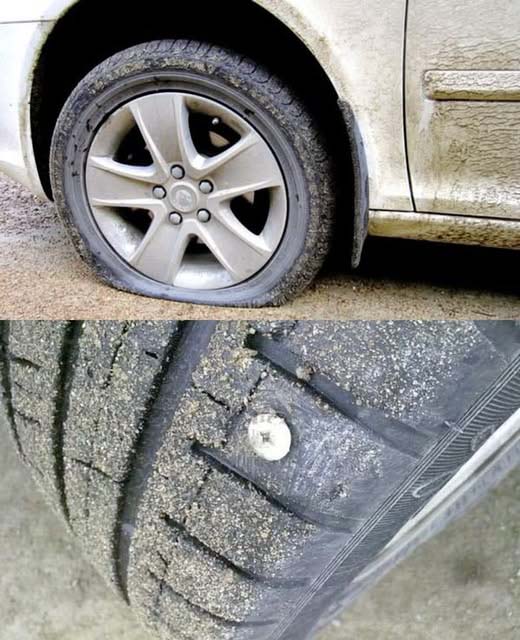ADVERTISEMENT
Activate your hazard lights immediately. This is a crucial safety measure, as it alerts other drivers to your presence and warns them that you are experiencing an issue. Your lights will make it easier for other vehicles to see you, especially in low visibility conditions, such as at night or in poor weather.
4. Assess the Situation Safely
Once you’ve safely pulled over, take a moment to assess the situation. Before getting out of your vehicle, ensure that it is safe to exit. Be mindful of the traffic around you, and only leave the vehicle if you are confident you are far enough from moving cars. If you’re on a busy highway or at high speeds, it might be safer to wait in the vehicle until help arrives.
If you’re comfortable doing so, check for visible damage on the tire. You may notice a puncture or a visible nail or sharp object that caused the flat. However, remember that do not attempt to fix the tire if you’re not comfortable with the process or if it’s dangerous to do so in your location.
5. Use a Tire Repair Kit (If You Have One)
If you have a tire repair kit in your car, you may be able to fix the puncture temporarily. These kits are especially handy for small punctures and can be used if you’re confident in using the tools provided.
Most tire repair kits will include:
- A sealant that can temporarily patch the hole.
- A plug tool to insert a rubber plug into the hole.
- Instructions on how to use the kit to ensure a secure seal.
If the puncture is small and located on the tread (not the sidewall), you may be able to seal the hole and drive to a repair shop. However, this is a temporary fix, and the tire should be replaced or repaired as soon as possible.
6. Change the Tire (If You’re Equipped and Able)
If you have a spare tire and the necessary tools, changing the tire yourself can save you time and money. Here’s how to safely change a flat tire:
- Locate Your Spare Tire: Typically, the spare tire, jack, and lug wrench are stored in your trunk or under the rear of the vehicle.
- Use the Jack to Lift the Vehicle: Place the jack in the appropriate spot (usually indicated in the vehicle’s manual) and lift the car until the flat tire is off the ground.
- Loosen the Lug Nuts: Before lifting the vehicle, use the lug wrench to slightly loosen the lug nuts on the flat tire. Once the car is lifted, remove the nuts completely.
- Remove the Flat Tire: Carefully pull the flat tire off and set it aside.
- Install the Spare Tire: Place the spare tire on the hub, ensuring it is aligned with the lug bolts. Secure it by tightening the lug nuts in a criss-cross pattern to ensure even pressure.
- Lower the Car: Once the tire is in place, slowly lower the vehicle and tighten the lug nuts again to ensure the tire is secure.
7. If You Can’t Change the Tire Yourself, Call for Help
If you’re unable to change the tire yourself, or if you don’t feel comfortable doing so, don’t hesitate to call for roadside assistance. Many insurance companies offer roadside assistance as part of their service. You can also call a local towing company or a service like AAA for help.
If you’re on the highway and feel unsafe, stay in the vehicle and wait for assistance. It’s better to be cautious than to attempt repairs in a dangerous situation.
For Complete Cooking STEPS Please Head On Over To Next Page Or Open button (>) and don’t forget to SHARE with your Facebook friends
8. Drive Carefully After the Repair
Once you’ve either repaired the tire or replaced it with a spare, it’s important to drive cautiously. Check the pressure in your spare tire before driving. Many spares are temporary “donut” tires, which are meant to be driven on only for a short distance and at lower speeds. Aim to get your damaged tire repaired or replaced as soon as possible.
9. Prevent Future Punctures
Once you’re safely on the road again, consider taking steps to reduce the likelihood of future punctures:
- Regular Tire Maintenance: Check your tire pressure regularly, as underinflated tires are more likely to be punctured. Look for signs of wear and tear, and replace any tires that are getting old.
- Tire Protection: Be mindful of the road conditions. Avoid driving over debris or potholes when possible. Some drivers even choose to install puncture-proof tire inserts or run-flat tires for additional peace of mind.
Conclusion
A puncture on the highway can be stressful, but knowing how to react can make the process safer and easier. Whether you choose to fix the tire yourself, use a tire repair kit, or call for roadside assistance, keeping your cool and staying focused on safety is the most important step. Always be prepared by carrying a spare tire, a jack, and other essential tools, and make sure you’re familiar with how to use them. If you’re not comfortable with changing the tire yourself, don’t hesitate to call for help.
By following these steps, you’ll minimize the risks and get back on the road quickly and safely. Safe travels!
